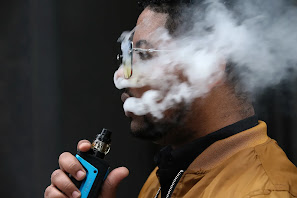Vapers or hookah users may be at greater risk for nose and sinus cancers, and upper respiratory ailments, than cigarette smokers

Photo by Antonio Perez/Chicago Tribune, via Alamy
—–
Electronic cigarette vapers and hookah smokers are more than twice as likely to exhale particles through their nose compared with cigarette smokers, who favor exhaling the emissions from their mouth, says a study led by researchers at New York University.
The study discreetly followed 341 men and women from March 2018 to February 2019, and they found that vapers and hookah smokers exhaled through their nose (63% and 50% respectively). By contrast, only 22% of cigarette smokers did the same. The study is published in the journal Tobacco Use Insights.
“Our findings suggest that the unique way vapers and hookah smokers use their devices may expose the nose and sinuses to far more emissions than cigarettes, which may in turn increase their risk for upper respiratory diseases,” says the study’s lead author, Emma Karey.
Experts have long known that smoking techniques for traditional tobacco products can influence which parts of the respiratory tract are at highest risk for disease. Past studies have shown, for example, that cigarette smokers, who tend to inhale more deeply, more frequently develop lung cancer. Cigar smokers, who tend to breathe more shallowly, are more likely to develop mouth and throat cancers. However, the new study is the first to examine exhalation patterns in e-cigarette and hookah pipe users outside of a controlled laboratory setting, says Karey.
“Because vaping and hookah devices are used differently than traditional cigarettes, we need to consider diseases of both the nose and lungs to evaluate their safety before judging whether one is more risky than another,” says study senior author Terry Gordon.
Gordon notes that in a related study, the research team identified increased damage in the nasal passages of vapers and hookah users but not in cigarette smokers, lending credence to the concern. He cautions, however, that the investigators still need to determine whether this nasal damage seen in vapers is truly a result of their unique breathing pattern and not due to an unrelated issue.